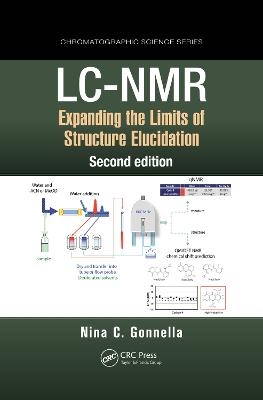
LC-NMR
CRC Press (Verlag)
978-1-138-49340-7 (ISBN)
investigations. This edition includes implementation and application of qNMR and automated and practical use of computational
chemistry combined with QM and DFT to predict highly accurate NMR chemical shifts.
The isolation and structural characterization of substances present at very low concentrations, as is necessary to satisfy regulatory requirements for pharmaceutical drug degradants and impurities, can present scientific challenges. The coupling of HPLC with NMR spectroscopy has been at the forefront of cutting-edge technologies to address these issues. LC-NMR: Expanding the Limits of Structure Elucidation presents a comprehensive overview of key concepts in HPLC and NMR that are required to achieve definitive structure elucidation with very low levels of analytes. Because skill sets from both of these highly established disciplines are involved in LC-NMR, the author provides introductory background to facilitate readers’ proficiency in both areas, including an entire chapter on NMR theory.
The much-anticipated second edition provides guidance in setting up LC-NMR systems, discussion of LC methods that are compatible with NMR, and an update on recent hardware and software advances for system performance, such as improvements in magnet design, probe technology, and solvent suppression techniques that enable unprecedented mass sensitivity in NMR. This edition features methods to quantify concentration and assess purity of isolated metabolites on the micro scale and incorporates computational approaches to accelerate the structure elucidation process. The author also includes implementation and application of qNMR and automated and practical use of computational chemistry combined with QM and DFT to predict highly accurate NMR chemical shifts. The text focuses on current developments in chromatographic-NMR integration, with particular emphasis on utility in the pharmaceutical industry. Applications include trace analysis, analysis of mixtures, and structural characterization of degradation products, impurities, metabolites, peptides, and more. The text discusses novel uses and emerging technologies that challenge detection limits as well future directions for this important technique. This book is a practical primary resource for NMR structure determination—including theory and application—that guides the reader through the steps required for isolation and NMR structure elucidation on the micro scale.
Nina C. Gonnella, Ph.D. is a Senior Associate Director at Boehringer Ingelheim (BI) where she heads a molecular structure and solid form informatics group, encompassing NMR Spectroscopy, Mass Spectrometry, Single Crystal X-ray and Computational Chemistry. She has extensive experience leading Pharmaceutical Research and Development groups spanning structural characterization /ligand screening and in-vitro and in-vivo biological studies. Nina received her Ph.D. in Synthetic Organic Chemistry from the University of Pennsylvania and subsequently held postdoctoral positions at California Institute of Technology and Columbia University. Prior to joining BI, Nina was group leader / manager at Novartis where she established and led an NMR group in areas that included, small molecule characterization, protein-ligand structure elucidation and in-vivo drug metabolism. She has advanced discovery research through application of structure based drug design and ligand based screening technologies to identify and optimize new lead series in both kinase and protease programs. Nina also held a position as adjunct professor at the University of Medicine & Dentistry of NJ (UMDNJ) (Graduate Program). She subsequently joined AbbVie as Group Leader of an NMR-LC-MS group with focus on protein-ligand binding studies. At BI, Nina has advanced BI projects through the development of innovative solutions. She championed solid state NMR as a company-wide Center of Expertise and initiated the acquisition of small molecule single crystal X-ray for global R&D. She introduced "state of the art" performance in integrating LC-NMR and micro-cryo probe NMR technology to enable elucidation of micro-scale degradation products and impurities. Nina initiated and led an international team in the development of powerful commercial ready in-silico structure elucidation programs that use quantum chemistry, density functional theory and probability theory to solve challenging chemical structures. Nina co-founded, organized and chaired a new Gordon Research Conference in "Molecular Structure Elucidation." She has served on scientific review boards, published over 95 peer review journal articles, authored book chapters, taught courses and presented numerous national and international lectures.
Chapter 1 Introduction to LC-NMR Chapter 2 NMR Theory Chapter 3 Separation Methods Chapter 4 NMR Instrumentation and Probe Technologies Chapter 5 NMR-Associated Isolation Technologies Chapter 6 NMR Experiments Chapter 7 Applications Chapter 8 Other Specialized Flow NMR Chapter 9 Quantitation of Isolated Compounds Chapter10 QM/DFT Chemical Shift Prediction
| Erscheinungsdatum | 31.01.2020 |
|---|---|
| Reihe/Serie | Chromatographic Science Series |
| Zusatzinfo | 21 Tables, black and white; 56 Illustrations, color; 80 Illustrations, black and white |
| Verlagsort | London |
| Sprache | englisch |
| Maße | 178 x 254 mm |
| Gewicht | 970 g |
| Themenwelt | Medizin / Pharmazie ► Medizinische Fachgebiete ► Pharmakologie / Pharmakotherapie |
| Naturwissenschaften ► Chemie ► Analytische Chemie | |
| Naturwissenschaften ► Chemie ► Physikalische Chemie | |
| ISBN-10 | 1-138-49340-6 / 1138493406 |
| ISBN-13 | 978-1-138-49340-7 / 9781138493407 |
| Zustand | Neuware |
| Informationen gemäß Produktsicherheitsverordnung (GPSR) | |
| Haben Sie eine Frage zum Produkt? |
aus dem Bereich


